Nigeria secures release of 100 kidnapped children, reports say
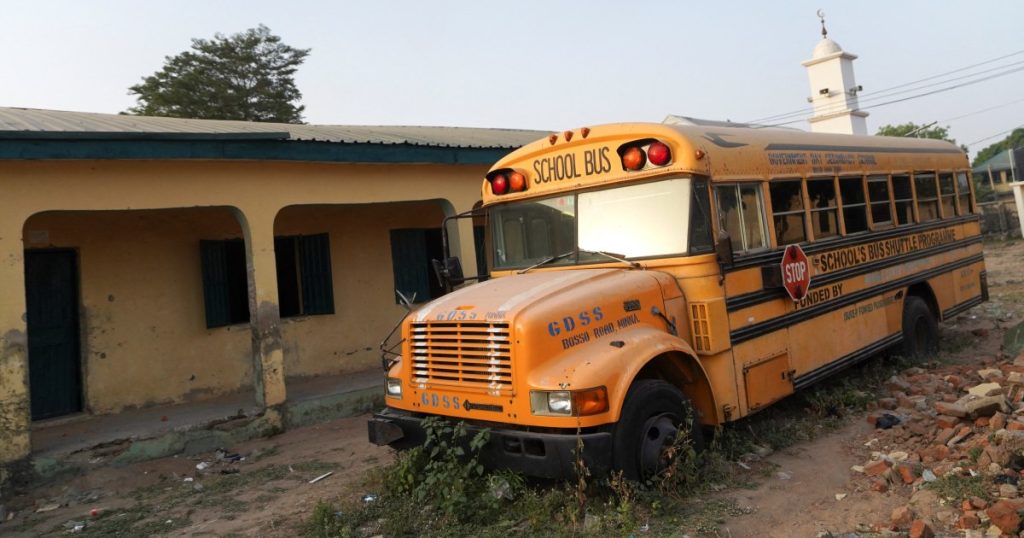
At least 153 students and 12 teachers taken from a Catholic school last month remain in captivity. Nigerian authorities have secured the release of 100 children who were among hundreds kidnapped from a Catholic school in northern Nigeria last month, officials and local media have reported. The 100 children arrived in Nigeria’s capital, Abuja, and are set to be handed over to local government officials in Niger State on Monday, an unnamed United Nations source told the AFP news agency. Recommended Stories list of 4 itemsend of list “They are going to be handed over to Niger State government tomorrow,” the source told the AFP news agency. Nigeria’s The Guardian newspaper reported on Sunday that the rescued children were receiving medical evaluations and would be reunited with their families after a debriefing. Presidential spokesman Sunday Dare also confirmed reports to the AFP that 100 children were being freed. Armed gunmen kidnapped 303 students and 12 teachers from St Mary’s School in the Papiri community of Niger State’s Agwara district on November 21. They included both male and female students aged between 10 to 18 years, according to the Christian Association of Nigeria (CAN). Fifty of the students escaped captivity in the days after they were kidnapped, returning home to their families. Following the release of 100 students on Sunday, 153 students and 12 teachers are believed to remain in captivity. Days earlier, gunmen abducted 25 schoolgirls from the Government Girls Comprehensive Secondary School in the neighbouring Kebbi State’s Maga town,170km (106 miles) away. “We have been praying and waiting for their return. If it is true, then it is a cheering news,” said Daniel Atori, spokesman for Bishop Bulus Yohanna of the Kontagora diocese, which runs the school. Advertisement “However, we are not officially aware and have not been duly notified by the federal government.” The latest abductions are the worst seen in Nigeria since more than 270 girls from Chibok town were snatched from their school in 2014. In total, more than 1,400 Nigerian students have been kidnapped since 2014, in almost a dozen separate incidents. The most recent kidnappings came soon after United States President Donald Trump said that Nigeria’s Christians are facing genocide, a claim that has been questioned by local officials and Christian groups, who say that people from different faiths have been caught up in ongoing violence in parts of the country. Kimiebi Imomotimi Ebienfa, a spokesman for Nigeria’s Ministry of Foreign Affairs, told Al Jazeera last month that people of all faiths have been affected by the ongoing violence. “We’ve continuously made our point clear that we acknowledge the fact that there are killings that have taken place in Nigeria, but those killings were not restricted to Christians alone. Muslims are being killed. Traditional worshippers are being killed,” Ebienfa said. “The majority is not the Christian population.” Trump has threatened military intervention in Nigeria, alleging that the country is failing to protect Christians from persecution. He has also threatened to cut aid to Nigeria. Nigeria, a country of more than 200 million people, is divided between the largely Muslim north and mostly Christian south. According to Pew Research Center estimates, Muslims make up 56 percent of Nigeria’s population, while Christians make up just more than 43 percent. Armed groups have been engaged in a conflict that has been largely confined to the northeast of the country, which is majority Muslim, and has dragged on for more than 15 years. Adblock test (Why?)
WFP says six million starving in Sudan
[unable to retrieve full-text content] Carl Skau, deputy executive director at the World Food Programme, talks limitations concerns in Sudan
‘Stop killing us’: Huge crowds rally in Brazil, decrying rise in femicide
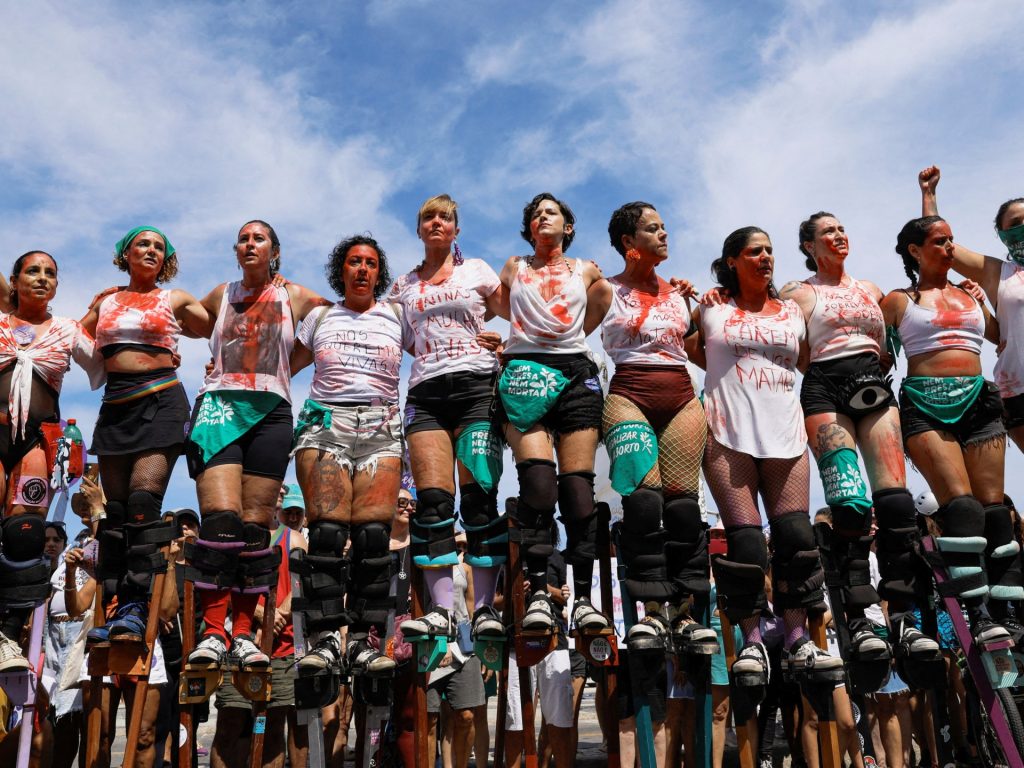
Demonstrators march in Rio de Janeiro, Sao Paulo and other cities, calling for an end to femicide, rape and misogyny. Tens of thousands of women have marched in cities across Brazil, denouncing femicide and gender-based violence, after a series of high-profile cases that shocked the country. Women of all ages and some men took to the streets in Rio de Janeiro, Sao Paulo and other cities on Sunday, calling for an end to femicide, rape and misogyny. Recommended Stories list of 4 itemsend of list In Rio, the protesters put out dozens of black crosses, while others bore stickers with messages such as “machismo kills”. And in Sao Paulo, the demonstrators chanted, “Stop killing us”, and held placards that read, “Enough of femicide”. The protesters in Rio’s Copacabana included Alline de Souza Pedrotti, whose sister was killed on November 28 by a male colleague. Pedrotti said the person who killed her sister, an administrative employee at a school, did not accept having female bosses. “I’m devastated,” she told The Associated Press news agency. “But I’m fighting through the pain, and I won’t stop. I want changes in the legislation and new protocols to prevent this kind of crime from happening again.” The protesters also denounced other shocking cases that took place last month in Sao Paulo and in the southern city of Florianopolis. In Sao Paulo on November 28, Taynara Souza Santos was run over by her ex-boyfriend and trapped by the car, which dragged her over concrete for one kilometre (0.6 mile). The 31-year-old’s injuries were so severe, her legs were amputated. Video footage of the incident went viral. And in Florianopolis on November 21, English teacher Catarina Kasten was raped and strangled to death on a trail next to a beach on her way to a swimming lesson. Advertisement These recent cases were “the final straw”, said Isabela Pontes, who was on Sao Paulo’s Paulista Avenue. “I have suffered many forms of abuses, and today, I am here to show our voice.” A decade ago, Brazil passed a law recognising the crime of femicide, defined as the death of a woman in the domestic sphere or as resulting from contempt for women. Last year, 1,492 women were victims of femicide, the highest number since the law was introduced in 2015, according to the Brazilian Forum on Public Safety. “We’re seeing an increase in numbers, but also in the intensity and cruelty of violence,” said Juliana Martins, an expert in gender-based violence and institutional relations manager at the Brazilian Forum on Public Safety. More women are speaking out against violence targeting them, and have gained visibility in the public sphere, Martins said. “Social transformations seeking equality of rights and representation generate violent responses aimed at reaffirming women’s subordination,” she said. In Rio, Lizete de Paula, 79, said men who hate women had felt empowered during the term of former President Jair Bolsonaro, who dismantled public policies aimed at strengthening women’s rights. “Women are increasingly entering new spaces and macho men can’t stand this,” the former architect said. Joao Pedro Cordao, a 45-year-old father of three daughters, said men have a duty to stand with women by calling out misogyny, not only at protests but in day-to-day life. “Only then will we be able to put an end to – or at least reduce – the current violence against women,” he said. Adblock test (Why?)
Japan accuses Chinese jets of directing fire-control radar at its aircraft
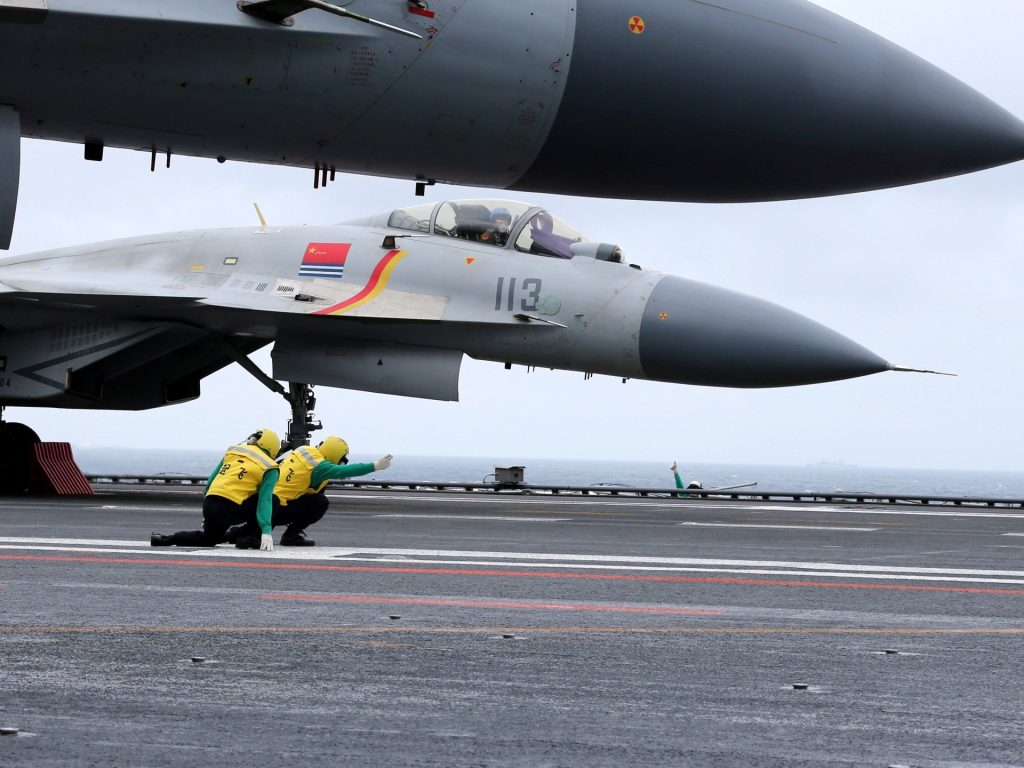
Japan’s defence minister condemns incidents as ‘dangerous’ and says that that Tokyo has lodged a ‘strong protest’ with Beijing. Japanese Minister of Defence Shinjiro Koizumi has accused Chinese fighter jets of directing their fire-control radar at Japanese aircraft during two separate incidents over international waters near the island of Okinawa. In a post on X early on Sunday, Koizumi said that Tokyo has lodged a “strong protest” about the two incidents and made “a stern demand for measures to prevent recurrence”. Recommended Stories list of 3 itemsend of list “The radar illumination… was a dangerous act that exceeded the range necessary for safe aircraft flight,” he added. There was no immediate comment from China. A fire-control radar lock is one of the most threatening acts a military aircraft can take, because it signals a potential attack, forcing the targeted aircraft to take evasive action. The encounters over the islands, which are close to disputed territory claimed by both Japan and China, are the most serious run-ins between the two militaries in years. They came as relations between the two countries sour over Japanese Prime Minister Sanae Takaichi declaring in November that Tokyo could respond to Chinese military action against Taiwan if the moves also threatened Japan’s security. Democratically governed Taiwan is claimed by Beijing and lies just 110km (68.4 miles) from Japan’s westernmost Yonaguni Island. Japan hosts the biggest overseas concentration of United States military power, including warships, aircraft and troops, with a big chunk of that contingent, including thousands of US Marines, based in Okinawa. There was no immediate comment from the US on Japan’s claims about China’s radar use. Advertisement According to Koizumi, the Chinese J-15 jets involved in the two incidents on Saturday were launched from China’s Liaoning aircraft carrier, which was manoeuvring south of the Okinawan islands along with three missile destroyers. “It is extremely regrettable that such incidents have occurred,” Koizumi’s statement said. No damage or injuries were reported from Saturday’s incidents near Okinawa, Koizumi added in his post. The Reuters news agency, citing sources and intelligence reports, said that China deployed a large number of naval and coastguard ships across East Asian waters on Thursday. The boats at one point numbered more than 100, Reuters reported. Taiwan’s government described that build-up as posing a threat to the Asia Pacific region. Japan said it was monitoring Chinese activity closely. Taiwan’s coastguard said on Sunday that it was monitoring drills by three Chinese maritime safety ships on the western side of the Taiwan Strait’s median line, but said the situation in the waters surrounding Taiwan was currently “normal”. Chinese state media said the search-and-rescue drills were in the central waters of the Taiwan Strait, patrolling “high-traffic areas, and areas with frequent accidents”. Taiwan’s coastguard said China was using “misleading and false wording” about what it was doing, with the aim of harassing Taiwan and carrying out psychological warfare. China claims it alone exercises sovereignty and jurisdiction over the strait, a major trade route for about half of global container ships. The US and Taiwan say the strait is an international waterway. Adblock test (Why?)
Hong Kong votes in ‘patriots only’ polls amid anger over deadly fire
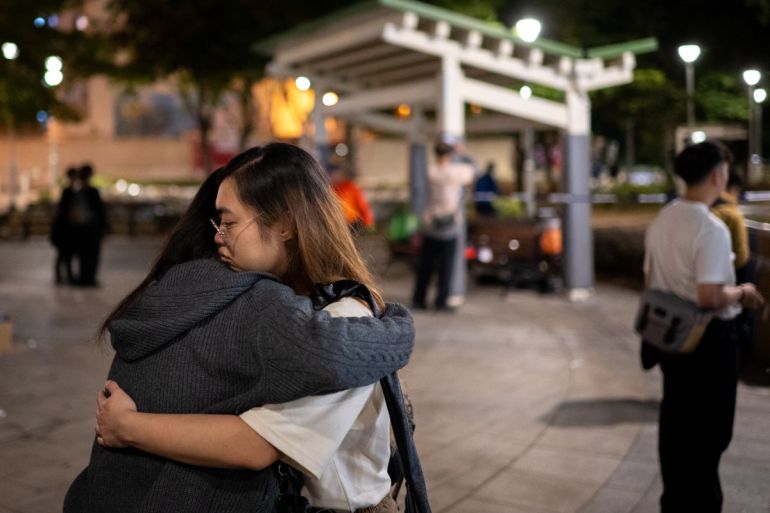
Hong Kong Chief Executive John Lee urges the public to come out and vote amid expectations of a low turnout. Voters in Hong Kong are heading to the polls to elect new lawmakers under China’s “patriots only” rules, though government efforts to drive turnout have been overshadowed by anger over the city’s handling of a major deadly fire. Polls opened early on Sunday across the autonomous Chinese city to select 90 legislators, though only 20 of those seats are directly elected. Recommended Stories list of 3 itemsend of list The election is only the second time since the city overhauled the electoral system to ensure that only those deemed “patriots” can run for office. Political campaigning for the polls was abruptly paused in late November, after a blaze tore through the housing blocks of Wang Fuk Court in northern Hong Kong, killing at least 159 people. Al Jazeera’s Laura Westbrook, reporting from Hong Kong, said “there had been some questions” whether the voting should go ahead in light of the tragedy, believed to be the world’s deadliest residential building fire since 1980. “But Hong Kong’s chief executive, John Lee, said the vote should go ahead, as a way to maintain stability, and that he needed the newly elected legislature to help push through reforms as well as ensure the recovery and reconstruction efforts can move ahead quickly,” Westbrook said. Lee had earlier announced a judge-led “independent committee” to investigate the fire, which devastated seven apartment blocks that were undergoing renovations. He has also urged the people of Hong Kong to take part in the polls, saying their ballots represented reform and support to the fire victims. Advertisement On Sunday, a sombre-looking Lee was seen casting his vote in the city. Political campaigning was abruptly paused after a blaze tore through the housing blocks of Wang Fuk Court in northern Hong Kong in late November, killing at least 159 people, and triggering public anger over the handling of the tragedy [Philip Fong/AFP] As of this week, police have arrested 15 people from various construction companies on suspicion of manslaughter. Police also reportedly arrested at least three people for sedition for making public criticism of the government in the wake of the fire. Among those detained was 24-year-old student Miles Kwan, who handed out flyers calling for government accountability. Kwan was later reported to have been released. Earlier this week, a university in the city also shut operations of its student union after messages were posted on campus expressing condolences and urging justice for the victims of the fire. Legislative elections in Hong Kong used to entail boisterous clashes between pro-Beijing and pro-democracy camps, with the latter often winning about 60 percent of the popular vote. But in 2020, Beijing imposed a sweeping national security law after the city was roiled by huge and sometimes violent pro-democracy protests. The first contest held under the new rules later that year saw a record low turnout of less than 30 percent. Some pro-democracy lawmakers have been jailed, including as part of a subversion case that concluded last year, while others resigned or fled Hong Kong. Sunday’s race will once again be devoid of the two largest pro-democracy parties after the Civic Party disbanded in 2023 and the Democratic Party said it is winding down. Before the fire, authorities had blanketed much of the city in promotional material and extended the operating hours of polling stations. About a third of the outgoing cohort of lawmakers, including veterans such as Regina Ip and legislature president Andrew Leung, are not seeking another term. Adblock test (Why?)
Supporters of Venezuela’s Machado rally in cities around the world
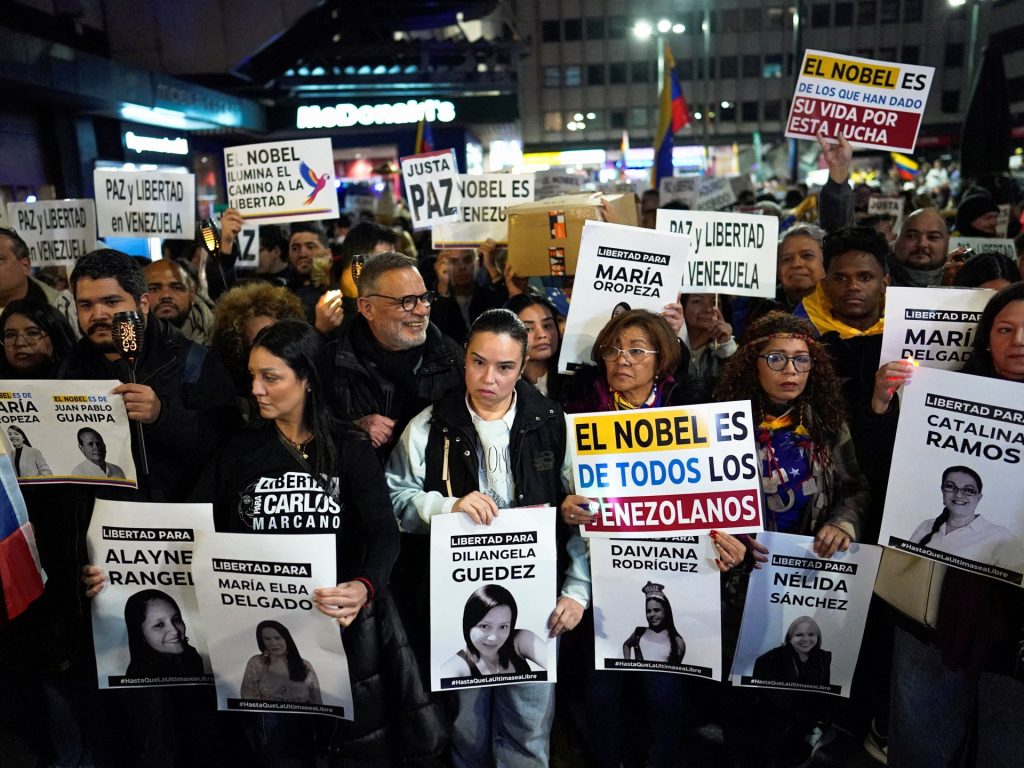
Supporters of Venezuelan opposition leader Maria Corina Machado have rallied in countries around the world to celebrate her Nobel Peace Prize win ahead of Wednesday’s award ceremony Thousands of people marched through Madrid, Utrecht, Buenos Aires, Lima, Brisbane and other cities on Saturday in support of 58-year-old Machado, who won the Nobel award for her struggle to achieve a democratic transition in Venezuela. Recommended Stories list of 4 itemsend of list The crowd in Peru’s capital, Lima, carried portraits of Machado and demanded a “Free Venezuela”. With the country’s yellow, blue and red flag draped over their backs or emblazoned on their caps, demonstrators clutched posters that read, “The Nobel Prize is from Venezuela.” Veronica Duran, a 41-year-old Venezuelan who has lived in Lima for eight years, said Machado’s Nobel Peace Prize is celebrated because “it represents all Venezuelans, the fallen and the political prisoners in their fight to recover democracy”. Machado, who has been in hiding since August 2024, wants to use the attention gained by the award to highlight Venezuela ‘s democratic aspirations. Her organisation said it expected demonstrations in more than 80 cities around the world. In Colombia, a group of Venezuelans gathered in the capital, Bogota, wearing white T-shirts and carrying balloons as part of a religious ceremony in which supporters asked that the Nobel Peace Prize “be a symbol of hope” for the Venezuelan people. Meanwhile, in Argentina’s capital of Buenos Aires, some 500 people gathered on the steps of the law school at the country’s largest university, improvising a torchlit march with their mobile phones. Advertisement “We Venezuelans in the world have a smile today, because we celebrate the Nobel Prize of María Corina and of the entire Venezuelan diaspora, and of all the brave people within Venezuela who have sacrificed themselves… we have so many martyrs, heroes of the resistance,” said Nancy Hoyer, a 60-year-old supporter. The gatherings come at a critical point in the country’s protracted crisis as the administration of United States President Donald Trump builds up a massive military deployment in the Caribbean, threatening repeatedly to strike Venezuelan soil. Venezuelan President Nicolas Maduro’s has branded the US operation an effort to end his hold on power. The Trump administration has said it does not recognise Maduro, who has been in power since 2013, as Venezuela’s legitimate president. Maduro claimed a re-election victory last year in a national ballot that the US and other Western governments dismissed as a sham, and which independent observers said the opposition won overwhelmingly. Machado had won the opposition’s primary election and intended to run against Maduro, but the government barred her from running for office. Retired diplomat Edmundo Gonzalez, who had never run for office before, took her place. The lead-up to the July 28, 2024, election saw widespread repression, including disqualifications, arrests and human rights violations. It all increased after the country’s National Electoral Council, which is stacked with Maduro loyalists, declared him the winner despite credible evidence to the contrary. Gonzalez sought asylum in Spain last year after a Venezuelan court issued a warrant for his arrest. Meanwhile, Machado went into hiding and has not been seen in public since January 9, when she was briefly detained after joining supporters in what ended up being an underwhelming protest in Caracas, Venezuela’s capital. The following day, Maduro was sworn in for a third six-year term. “We are living through times where our composure, our conviction and our organisation are being tested,” Machado said in a video message shared on Tuesday on social media. “Times when our country needs even more dedication, because now, all these years of struggle, the dignity of the Venezuelan people, have been recognised with the Nobel Peace Prize.” Machado won the award on October 10 for keeping “the flame of democracy burning amid a growing darkness”. According to the head of the Nobel Institute, Machado has promised to go to Norway to pick up her prize on Wednesday. “I was in contact with Machado last night [Friday], and she confirms that she will be in Oslo for the ceremony,” Kristian Berg Harpviken told the AFP news agency. Advertisement “Given the security situation, we cannot say more about the date or how she will arrive,” he said. Adblock test (Why?)
South Africa shooting leaves 12 dead, including young child: Police
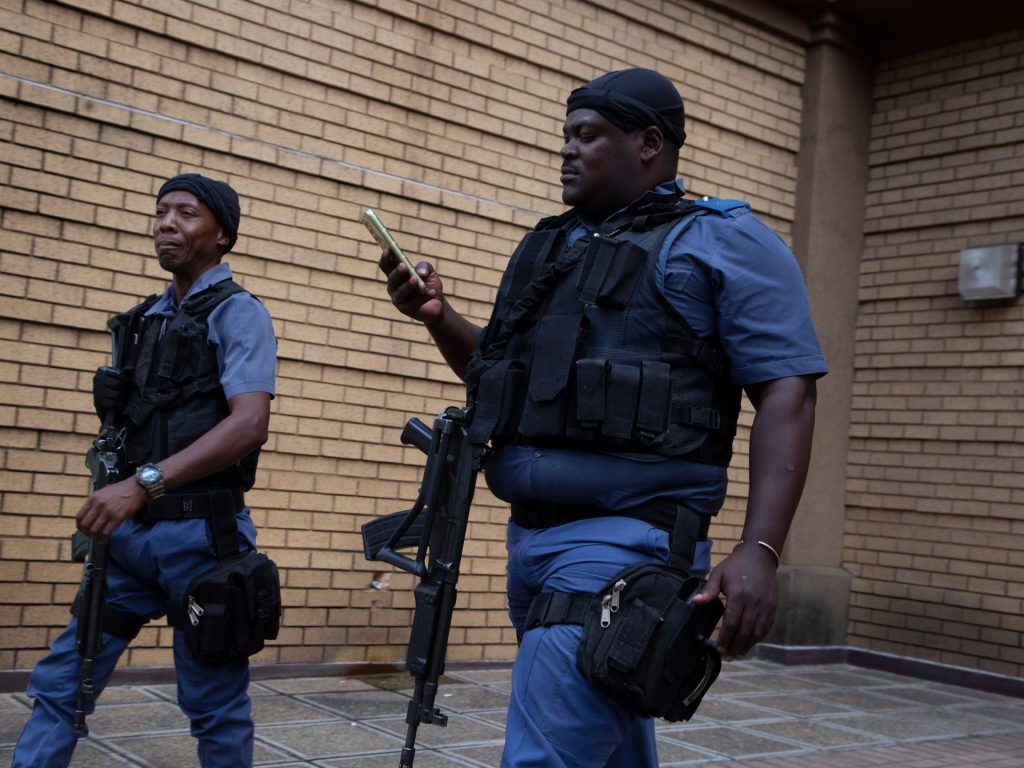
South Africa, grappling with entrenched crime and corruption, has one of the world’s highest murder rates. By News Agencies Published On 6 Dec 20256 Dec 2025 Click here to share on social media share2 Share Gunmen have killed at least 12 people, including a three-year-old boy, in a mass shooting at a bar near the South African city of Pretoria, according to police. Athlenda Mathe, spokesperson for the South African Police Service (SAPS), confirmed on Saturday that a total of 25 people were shot in the bar in Saulsville township, 18km (11 miles) west of Pretoria, adding that 14 had been taken to hospital. Recommended Stories list of 3 itemsend of list Police said three minors were among the dead in the shooting, including the three-year-old, a 12-year-old boy and a 16-year-old girl. The shooting occurred in what Mathe described as an “illegal shebeen” – or bar – within a hostel at about 4:30am (02:30 GMT), with three gunmen indiscriminately firing at a group of men who were drinking. Police were not alerted until about 6am (04:00 GMT). They said a manhunt had been launched and that the motive was as yet unknown. South Africa, the continent’s most industrialised nation, is grappling with entrenched crime and corruption driven by organised networks. The country has one of the world’s highest murder rates, spurred by robberies and gang violence, with some 63 people killed each day between April and September, according to police data. “We are having a serious challenge when it comes to these illegal and unlicensed liquor premises,” Mathe said, adding that they are where most mass shootings occur. “Innocent people also get caught up in the crossfire,” she told public broadcaster SABC. In October, two teenagers were killed and five wounded in a gang‑related shooting in Johannesburg, the country’s financial capital. Advertisement In another incident in May, gunmen killed eight customers at a tavern in the southeastern city of Durban. Last year, 18 relatives were shot dead at a rural homestead in the country’s Eastern Cape province. Many people in South Africa own licensed firearms for personal protection, but there are many more illegal guns in circulation. Adblock test (Why?)
Syria’s al-Sharaa promises peace and unity in face of Israeli aggression
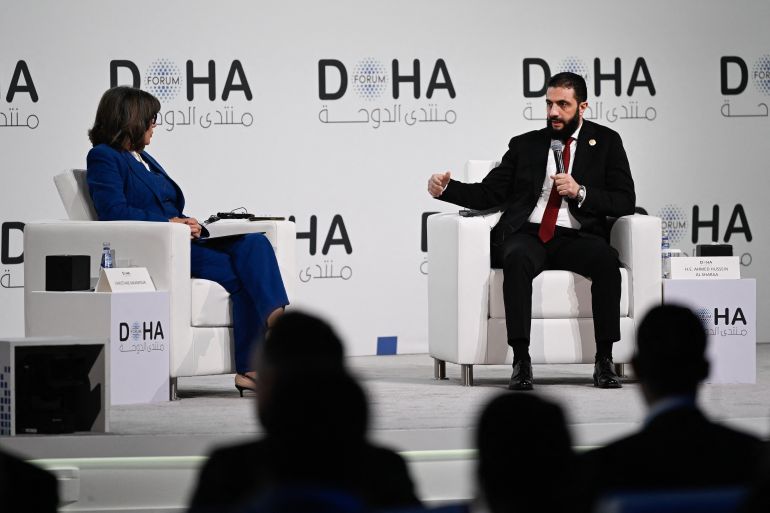
Doha, Qatar – Syria’s President Ahmed al-Sharaa accused Israel of heightening regional tensions and fabricating external threats to divert attention from the “horrifying massacres” it has committed in Gaza. Speaking to CNN’s Christiane Amanpour on Saturday during the Newsmaker Interview at the Doha Forum, al-Sharaa said Israeli leaders “often exports crises to other countries” as they increasingly invoke security pretexts to expand military action. Recommended Stories list of 3 itemsend of list “They justify everything, using their security concerns, and they take October 7 and extrapolate it to everything that is happening around them,” he said. “Israel has become a country that is in a fight against ghosts.” Since the the Bashar al-Assad regime fell in December 2024, Israel has carried out frequent air strikes across Syria, killing hundreds of people, while also conducting ground operations in the south. Last month, Israeli forces killed at least 13 people in the Damascus countryside town of Beit Jinn. In addition, it has advanced deeper into Syrian territory and established numerous checkpoints, while illegally detaining Syrian citizens and holding them inside Israel. Syrian President Ahmed al-Sharaa, right, speaks during the opening day of the Doha Forum [AFP] Al-Sharaa said his administration had worked to de-escalate tensions with Israel since he assumed office, emphasising that “we sent positive messages regarding regional peace and stability”. “We’ve said very frankly that Syria will be a country of stability, and we are not concerned with being a country that exports conflict, including to Israel,” he said. Advertisement “However, in return, Israel has met us with extreme violence, and Syria has suffered massive violations of our airspace.” ‘Syria attacked by Israel, not the opposite’ Al-Sharaa said Israel must withdraw to where they were before the fall of al-Assad, and preserve the 1974 Disengagement Accord. The accord established a ceasefire following the October 1973 Yom Kippur war, creating a United Nations-monitored buffer zone on the Israeli-occupied Golan Heights. “This agreement has held on for over 50 years,” al-Sharaa said, cautioning that efforts to replace it with new arrangements, such as a buffer or demilitarised zone, could push the region “into a serious and dangerous place”. “Who will protect that zone? Israel often says that they are afraid of coming under attack from southern Syria, so who will be protecting this buffer zone or this demilitarised zone, if the Syrian army or the Syrian forces are going to be there?” he asked. On Tuesday, Israeli Prime Minister Benjamin Netanyahu said a deal with Syria was within reach, but that he expected Syrian government forces to create a demilitarised buffer zone extending from the capital, Damascus, to Jabal al-Sheikh in the Israeli-occupied Syrian Golan Heights. “It is Syria that is being attacked by Israel and not the opposite,” he said. “Therefore, who has more right to claim a buffer zone and a pullout?” Unity in Syria On the question of unity, al-Sharaa said there was progress and ongoing challenges. “I believe Syria is living through its best days. We are talking about a country that’s aware, that’s conscious,” he said, while stressing that no country can achieve total “unanimity”. “This doesn’t occur even in advanced countries that are living through relative stability.”According to al-Sharaa, people in Syria “simply did not know each other well” due to issues inherited from the al-Assad regime. “We actually resorted to pardoning a large number of people and a large number of factions so that we can build a sustainable, safe and secure future for the Syrian people,” he added. Moreover, he rejected the notion the uprising against al-Assad was a “Sunni revolution”. “All the components of Syrian society were part of the revolution,” he said. “Even the Alawites had to pay the price of them being used by the former regime. So I do not agree with the definition or with saying that all the Alawites were supporting the regime. Some of them were living in fear.” Syria witnessed an outbreak of sectarian violence earlier this year, including in the coastal areas in March, where hundreds of people from the Alawite religious minority were killed, with members of the new government’s security forces among the perpetrators. Advertisement Fighting also broke out between government forces and their allies with Bedouin tribes in Suwayda in July, in which more than 1,400 people, mainly civilians, were killed. “We know that there are some crimes that were perpetrated … this is a negative thing,” he said. “I insist … that we do not accept what happened. But I say that Syria is a state of law, and the law rules in Syria, and the law is the only way to preserve everybody’s rights.” Many rights groups are concerned that women will be particularly at risk under the new government led by the former al-Qaeda operative, as al-Sharaa’s Hayat al-Tahrir group severely restricted women’s freedoms, including public participation and dress code, during their rule over Idlib in northwest Syria. On what the role of women looks like in Syria today, al-Sharaa said they were “empowered” under his rule. “Their rights are protected and guaranteed, and we constantly strive to ensure that women are fully participating in our government and our parliament as well,” he added. “I believe you should not fear for Syrian women, fear for Syrian men,” Sharaa joked. Elections to be held within five years Al-Sharaa stressed that Syria’s path forward lies in strengthening institutions rather than consolidating individual power, and that he was committed to conducting elections after the ongoing transition period ends. “Syria is not a tribe. Syria is a country, a country with rich ideas … I do not believe we are ready right now to undertake parliamentary elections,” he said. Nevertheless, al-Sharaa said parliamentary elections will take place within five years of when the temporary Constitutional Declaration was signed back in March, giving him the mandate to lead Syria through a five-year transition period. “The principle of people choosing their leaders is a basic principle … it is even part of our religion
World Cup 2026: Re-disappearing Mexico’s disappeared

The city of Guadalajara in Mexico is scheduled to host four World Cup matches next year, and labourers are working around the clock to revamp infrastructure in time for the tournament. On account of frenzied construction, the city’s roads are presently a bona fide mess, constituting a perpetual headache for those who must transit them. But Guadalajara has a much bigger problem than traffic. The metropolis is the capital of the western state of Jalisco, which happens to possess the highest number of disappeared people in all of Mexico. The official tally of Jalisco’s disappeared is close to 16,000, out of a total of more than 130,000 countrywide. However, the frequent reluctance of family members to report missing persons for fear of retribution means the true toll is undoubtedly higher. Now, with the World Cup fast approaching, Mexican authorities are also working overtime to sanitise Guadalajara’s image. For months, local officials have been threatening to remove the portraits and signs from the towering “roundabout of the disappeared” in the centre of the city, effectively re-disappearing them. I recently spent five days in Guadalajara and paid a visit to the roundabout, a few kilometres’ walk from my accommodation. The closer I got to the site, the more posters proliferated across electrical poles and sidewalk planters featuring the faces and identifying information of the disappeared. Some of these posters also appeared plastered in larger form onto the monument itself. There was, for example, 32-year-old Elda Adriana Valdez Montoya, last seen in Guadalajara on August 10, 2020. And 19-year-old Jordy Alejandro Cardenas Flores, last seen on May 19, 2022, in the nearby city of Tlaquepaque. There was 16-year-old Cristofer Aaron Leobardo Ramirez Camarena, last seen in the Jalisco municipality of Tlajomulco de Zuniga on April 21, 2024. And 67-year-old Martha Leticia Diaz Lopez, last seen in Guadalajara on June 27, 2025. Advertisement In the case of Cardenas Flores, the poster specified that the young man had been “taken” on May 19 by agents from the state prosecutor’s office, from which appointment he never returned. While there is a tendency to blame Mexico’s astronomical disappearance rates on violent drug cartels, including the notorious Jalisco New Generation Cartel, the government is thoroughly implicated in the phenomenon, as well – whether by direct action, collaboration with criminal outfits, or simply in terms of safeguarding the panorama of near-total impunity that permits such crimes to flourish. It bears underscoring, too, that the vast majority of disappearances took place following the launch in 2006 of Mexico’s so-called “war on drugs”, which not only failed to resolve the drug issue but also set the stage for more than 460,000 homicides in the country. The war effort was backed by – who else? – the United States, which rarely misses out on an opportunity for blood-soaked hemispheric meddling. But heaven forbid World Cup spectators be subjected to such a morbid reality – although it is becoming rather difficult to cover up the discovery of mass clandestine graves and hundreds of bags containing human remains in the vicinity of the Guadalajara football stadium. While in Guadalajara, I spoke with Maribel Cedeno, a representative of the Guerreros Buscadores de Jalisco (Warrior Searchers of Jalisco), one of various collectives dedicated to the search for the missing in the face of willful government inaction. Her brother, Jose Gil Cedeno Rosales, was disappeared on September 21, 2021, in Tlajomulco de Zuniga. As Cedeno commented to me, “absolutely nothing has changed” during the presidency of Claudia Sheinbaum, who assumed office last year after promising a more sympathetic approach to the issue of Mexico’s disappeared. Once in power, Sheinbaum apparently forgot her own pledge, effectively condemning countless Mexicans whose loved ones are missing to a state of continuous psychological torment. Remarking on the expansive measures the government is pursuing to provide security for the World Cup, Cedeno demanded: “But where is our security? Where is the security for our family members, or for those of us whose lives are at risk because we are searching for the missing?” They are good questions. And yet they are not ones that are keeping the authorities up at night. In March, the Guerreros Buscadores de Jalisco discovered a clandestine crematorium on a ranch outside the town of Teuchitlan, an hour from Guadalajara, which was reportedly utilised by the Jalisco New Generation Cartel as a recruitment and training centre in addition to an extermination site. Advertisement Curiously, Mexican authorities had seized the ranch months earlier, but hadn’t managed to notice any of the human bone fragments or the hundreds of shoes littering the place. On my final day in Guadalajara, I took an Uber out to the ranch, which appeared on the Uber app as “Campo de adiestramiento y exterminio” – training and extermination camp. Thinking better of it, I put the Teuchitlan town centre as my destination, and while en route proposed to the driver that I pay him in cash to swing by the ranch, as well. He made the sign of the cross, but agreed. A gregarious middle-aged man from eastern Jalisco, the driver had spent 11 years as an undocumented worker in California and Oregon; his son was studying engineering at a university in Michigan. He had personally known several people, including two sisters, who had been disappeared from his hometown, and lamented that the only time the Mexican authorities seemed inspired to seek justice for homicides was when the victims themselves had been members of the security forces. And although a die-hard football fan, the driver said he could not justify the state’s decision to pour massive quantities of money into a World Cup spectacle that would not remotely benefit the average Mexican. In Teuchitlan, we took a brief stroll around the town’s colourful central plaza and bought a few beers, then programmed our destination to “Campo de adiestramiento y exterminio”, which led us down a dusty and isolated road patrolled by an ominous black vehicle. When we found the camp blocked by the Mexican
Russia-Ukraine war: List of key events, day 1,381
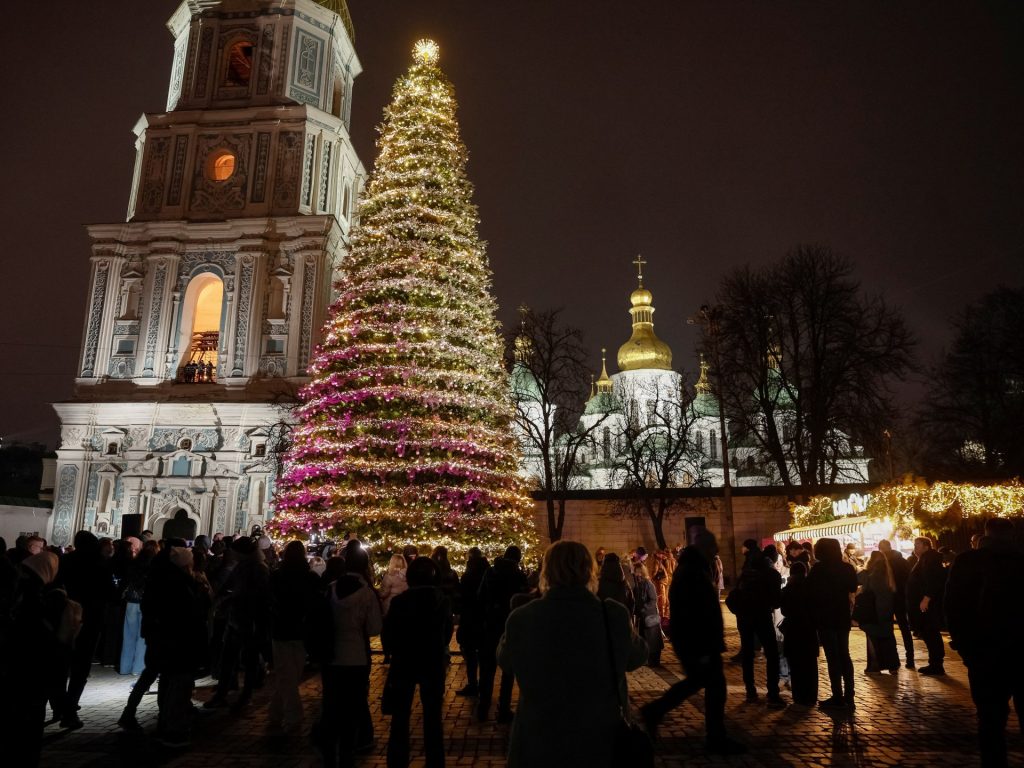
These are the key developments from day 1,381 of Russia’s war on Ukraine. Published On 6 Dec 20256 Dec 2025 Click here to share on social media share2 Share Here’s where things stand on Saturday, December 6: Fighting A Russian drone attack killed two men, aged 52 and 67, in the Ukrainian city of Izyum as they were unloading firewood from a truck, according to local officials. Russian forces also killed a 12-year-old boy in an attack on the Vasylkivska community in Ukraine’s Dnipropetrovsk region, and wounded more than a dozen Ukrainians in attacks on the Kherson, Donetsk and Sumy regions, local officials said. Ukraine’s national grid operator, Ukrenergo, announced that electricity restrictions would be in place nationwide from Saturday due to “previous Russian massive missile and drone attacks on energy facilities”, in a post on Telegram. Chechen leader Ramzan Kadyrov said that a Ukrainian drone hit and damaged a building in Grozny, the capital of Russia’s southern Chechnya region, and promised to retaliate. The attack caused no casualties, he said. A Ukrainian drone attack on Russia’s Belgorod region wounded the mayor of the village of Berezovka, according to officials, while Ukrainian assaults on energy facilities in Russian-occupied Luhansk caused electricity outages. Ukraine’s HUR military intelligence agency claimed attacks on military targets in Russian-occupied Crimea, including a Su-24 tactical bomber, while the Ukrainian military said it launched drone assaults on Russia’s Temryuk seaport in Krasnodar Krai and the Syzran Oil Refinery in Samara region overnight on Friday. The Russian Ministry of Defence said it downed 41 Ukrainian drones overnight on Friday, according to the TASS news agency. Russian investigators charged a Ukrainian Armed Forces commander with terrorism, in absentia, over the death of journalist and Russian Channel One military correspondent Anna Prokofieva in March this year, TASS reported. Politics and diplomacy Advertisement United States President Donald Trump’s special envoy Steve Witkoff held “productive” talks with Ukraine’s senior negotiator Rustem Umerov in Miami, Florida, on Thursday, a White House official said on Friday. “Progress was made,” the White House official said, according to the Reuters news agency. “They will reconvene later today after briefing their respective leaders.” The meetings in Florida came after Witkoff met Russian President Vladimir Putin in Moscow earlier this week, in what Yury Ushakov, the Kremlin’s top foreign policy adviser, described on Friday as “truly friendly” discussions. Ushakov also said that Jared Kushner, Trump’s son-in-law, is working “frantically” to resolve the war between Russia and Ukraine in his role as a US negotiator, TASS reported. European Commission President Ursula von der Leyen and German Chancellor Friedrich Merz said they held “very constructive” talks with Belgian Prime Minister Bart De Wever on Friday over a European Union plan to use Russian frozen assets to fund Ukraine, which Belgium has so far refused to endorse. The Save Ukraine NGO said it has returned 18 Ukrainian children, aged two to 17, from Russian-occupied territories in Ukraine’s Kherson region over the last week. International Criminal Court (ICC) prosecutors said on Friday that arrest warrants for Putin and five other Russians accused of war crimes in Ukraine will stay in place even if a blanket amnesty is approved during US-led peace talks. Putin said that Moscow is ready to provide “uninterrupted shipments” of fuel to India, as he met with Indian Prime Minister Narendra Modi in New Delhi on Friday, despite US sanctions. Bulgaria’s maritime authorities, border police and navy are attempting to recover sanctioned Russian tanker Kairos, which was hit in the Black Sea last week by a Ukrainian drone in Turkiye’s exclusive economic zone, leading to its crew being rescued after it caught fire. Adblock test (Why?)

